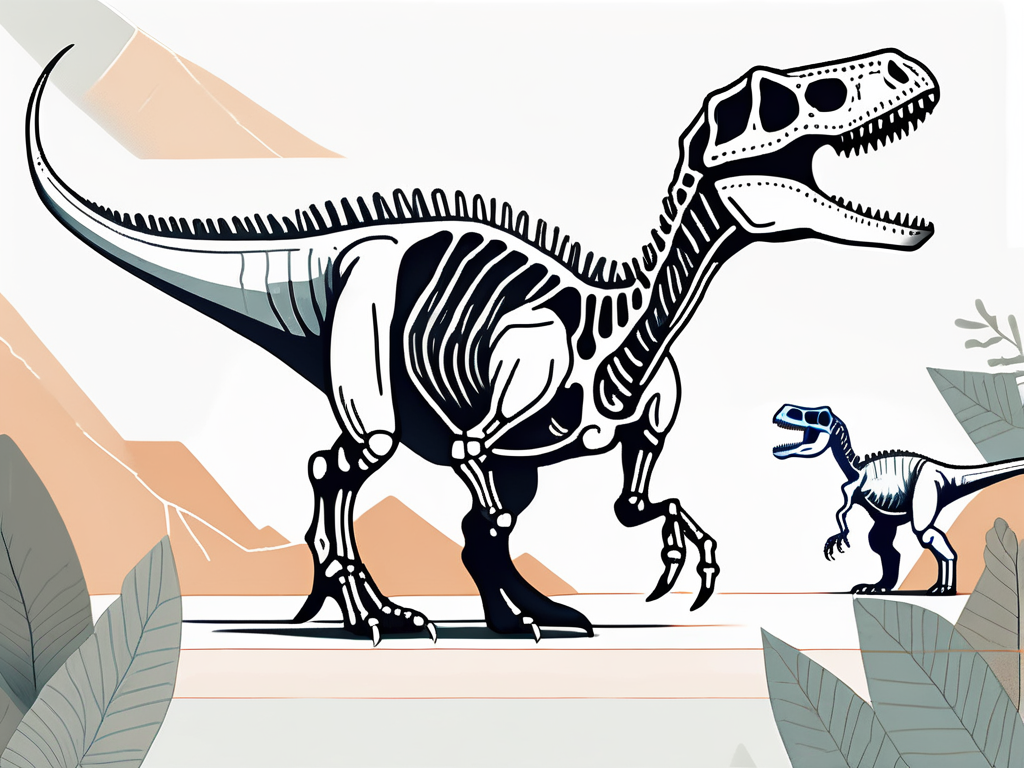Dinosaurs have fascinated both scientists and the general public for centuries. These remarkable creatures roamed the Earth millions of years ago, leaving behind fossil evidence that has allowed us to gain insights into their biology and behavior. One of the most interesting and well-established facts about dinosaurs is that they were reptiles. But how do we know this? Let’s dive into the classification, anatomical evidence, evolutionary connection, debunking common misconceptions, and the impact of paleontological research to understand why dinosaurs were categorized as reptiles.
Understanding the Classification of Dinosaurs
To comprehend why dinosaurs were considered reptiles, it’s important to understand the basics of animal classification. The animal kingdom is divided into various groups based on shared characteristics. Reptiles, birds, mammals, fish, and amphibians are examples of such groups. Within reptiles, dinosaurs were placed in a specific subgroup called archosaurs, which also includes crocodiles and birds.
Archosaurs are characterized by their upright stance, fully developed hind limbs, erect gait, and reptile-like scales or feathers. These features, among others, provide significant evidence that dinosaurs were indeed reptiles.
Furthermore, the classification of dinosaurs extends beyond just their reptilian traits. They are further categorized into two main groups: the Saurischia and the Ornithischia. Saurischian dinosaurs are known for their lizard-like hips, while Ornithischian dinosaurs have bird-like hips. This differentiation showcases the diverse evolutionary paths taken by these magnificent creatures.
It is fascinating to note that within these two main groups, dinosaurs further branch out into various families and genera, each with its own unique characteristics and adaptations. For example, the Tyrannosaurus rex belongs to the theropod subgroup of Saurischian dinosaurs, known for their carnivorous diet and bipedal stance. On the other hand, the Triceratops falls under the Ceratopsian subgroup of Ornithischian dinosaurs, recognized for their distinctive frills and horns.
The Anatomical Evidence
The anatomical evidence supporting the classification of dinosaurs as reptiles is extensive and compelling. Let’s explore two key areas of study: skeletal structures and skin impressions.

Skeletal Structures of Dinosaurs
Examining dinosaur skeletons reveals numerous reptilian features. One such feature is the presence of air-filled bones, a characteristic also seen in modern-day birds. Like reptiles, dinosaurs had a unique hip structure, with legs that extended outwards from their bodies, much like those of lizards. Additionally, their teeth and jaws resemble those of reptiles rather than mammals or birds.
Furthermore, the discovery of fossilized eggs and nests suggests that dinosaurs laid eggs, a reproductive trait commonly associated with reptiles. These distinctive skeletal structures provide substantial evidence that dinosaurs belonged to the reptile group.
Another fascinating aspect of dinosaur skeletal structures is the presence of elongated neural spines in certain species, such as the iconic Stegosaurus. These bony plates along the back of the dinosaur are reminiscent of structures found in some modern reptiles, serving as both defensive armor and temperature regulators. The intricate details of these neural spines offer valuable insights into the evolutionary adaptations of dinosaurs within the reptilian lineage.
Skin and Scale Impressions
In addition to studying bones, paleontologists have also analyzed skin impressions of various dinosaur species. These impressions reveal the presence of scales, which are characteristic of reptiles. Some dinosaur fossils even exhibit preserved skin texture, displaying the reptilian scales in intricate detail. Remarkably, these scales closely resemble those seen in modern reptiles, further solidifying the reptilian classification.
Moreover, recent advancements in technology have allowed researchers to conduct microscopic analysis of dinosaur skin impressions, unveiling the presence of pigment cells known as melanophores. These melanophores indicate that dinosaurs may have been adorned with a variety of colors, similar to many present-day reptiles. The study of skin impressions not only provides evidence of the reptilian nature of dinosaurs but also offers a glimpse into the vibrant and diverse appearances of these prehistoric creatures.
The Evolutionary Connection
To better understand why dinosaurs are classified as reptiles, we must consider their evolutionary connection to other reptilian creatures.
Exploring the evolutionary lineage of dinosaurs reveals a fascinating journey through time, showcasing their gradual development and adaptation within the reptilian family tree. From their early ancestors to the diverse species that roamed the Earth, dinosaurs have left an indelible mark on the history of life on our planet.
Dinosaurs and Modern Reptiles
Modern reptiles, such as lizards and crocodiles, share several characteristics with dinosaurs. They possess similar reproductive strategies, lay eggs, and have adaptations suited for a terrestrial lifestyle. The similarities between dinosaurs and modern reptiles, both in terms of behavior and physical traits, strengthen the argument for considering dinosaurs as reptiles.
Delving deeper into the comparison between dinosaurs and modern reptiles unveils a world of intriguing parallels and distinctions. While some reptilian lineages have evolved to survive in vastly different environments, the fundamental traits that connect dinosaurs to their modern counterparts underscore the enduring legacy of reptilian evolution.
The Role of Fossil Records
Fossil records play a crucial role in understanding dinosaur evolution. By examining fossils of dinosaur ancestors and comparing them to other reptiles, scientists have identified important transitional forms that highlight the evolutionary connection between dinosaurs and their reptilian relatives. These transitional fossils provide further evidence supporting the classification of dinosaurs as reptiles.
The meticulous study of fossil records not only sheds light on the physical characteristics of dinosaurs but also offers a glimpse into their behavior, ecology, and evolutionary relationships. Each fossil unearthed adds another piece to the puzzle of dinosaur evolution, enriching our understanding of these magnificent creatures that once ruled the Earth.
Debunking Common Misconceptions
Despite the overwhelming evidence, there are still misconceptions surrounding the reptilian nature of dinosaurs. Let’s address two common misconceptions and clarify the reality.

Dinosaurs vs Birds: The Confusion
The relationship between dinosaurs and birds has long been a topic of debate. While birds are descendants of dinosaurs, not all dinosaurs were birds. Dinosaurs encompass a much broader group of reptiles that existed before the emergence of birds. Although some dinosaurs had bird-like features, such as feathers and hollow bones, the majority of dinosaurs lacked these avian characteristics. Thus, dinosaurs should be regarded as reptiles rather than direct ancestors of birds.
It is fascinating to note that the link between dinosaurs and birds is further supported by recent fossil discoveries showing evidence of feathered dinosaurs. These feathered creatures provide a glimpse into the evolutionary transition from dinosaurs to birds, shedding light on the intricate connections between these two groups. The presence of feathers in certain dinosaur species challenges traditional perceptions and underscores the complexity of evolutionary pathways.
Dinosaurs and Mammals: The Differences
Another misconception is that dinosaurs were more similar to mammals than reptiles. While mammals and dinosaurs both belong to the broader group known as amniotes, they have distinct differences. Mammals possess unique characteristics such as hair, mammary glands, and a specialized skeletal structure to support live birth. Dinosaurs, on the other hand, lack these mammalian features and align more closely with reptilian traits. Hence, dinosaurs should be rightfully classified as reptiles.
Furthermore, the reproductive strategies of dinosaurs differ significantly from mammals. Dinosaurs laid eggs, a trait commonly associated with reptiles, while mammals give birth to live young. This fundamental contrast in reproductive methods highlights the evolutionary divergence between dinosaurs and mammals, emphasizing their separate evolutionary paths and biological adaptations to their environments.
The Impact of Paleontological Research
Paleontological research continues to advance our understanding of dinosaurs and their reptilian nature. Let’s explore the impact of such research on dinosaur studies and its future directions.

Advances in Dinosaur Studies
Modern techniques, such as computed tomography (CT) scanning and molecular analysis, have allowed scientists to gain deeper insights into the biology and behavior of dinosaurs. These technologies enable researchers to study the internal structures of fossils, further confirming their reptilian characteristics.
For example, CT scanning has revealed intricate details of dinosaur skulls, providing valuable information about their brain structure and sensory capabilities. By analyzing the preserved brain cavities, scientists have been able to reconstruct the size and shape of the dinosaur’s brain, offering insights into their cognitive abilities and sensory perception. This newfound knowledge has challenged previous assumptions and expanded our understanding of how dinosaurs interacted with their environment.
In addition to CT scanning, molecular analysis has revolutionized our understanding of dinosaur genetics. By extracting and sequencing DNA fragments from well-preserved dinosaur fossils, scientists have been able to uncover genetic information that was previously thought to be lost to time. This has allowed researchers to investigate the evolutionary relationships between dinosaurs and other reptiles, providing valuable insights into their evolutionary history.
Furthermore, interdisciplinary approaches that combine paleontology with other scientific disciplines, such as genetics and biomechanics, offer exciting avenues for future discoveries. By integrating these different fields of study, scientists can gain a more comprehensive understanding of dinosaurs and their place in the natural world.
Future Directions in Dinosaur Research
While much has been learned about dinosaurs being reptiles, many questions still remain unanswered. Ongoing research aims to uncover further details about the diversity, locomotion, and physiology of dinosaurs.
One area of interest is the study of dinosaur locomotion. By analyzing the structure of dinosaur bones and tracks, scientists can infer how these ancient creatures moved and interacted with their environment. Recent studies have suggested that some dinosaurs may have been capable of sustained high-speed running, challenging the traditional view of dinosaurs as slow and lumbering creatures.
Another exciting direction in dinosaur research is the study of dinosaur coloration. By analyzing fossilized pigments and using advanced imaging techniques, scientists have been able to reconstruct the colors and patterns of dinosaur skin. This has provided valuable insights into their camouflage strategies, social behavior, and even their interactions with other species.
By studying additional specimens and utilizing advancing technologies, scientists hope to shed more light on these prehistoric creatures and their reptilian lineage. With each new discovery, our understanding of dinosaurs and their place in the natural world continues to evolve.
In conclusion, the classification of dinosaurs as reptiles is based on a robust body of evidence. The examination of skeletal structures, skin impressions, the evolutionary connection to modern reptiles, and accurate interpretation of fossil records all support the reptilian nature of dinosaurs. By debunking common misconceptions and continuing to explore the field of paleontological research, we gain a deeper understanding of these prehistoric creatures and their place within the reptile group. Dinosaurs continue to captivate our imagination, serving as a reminder of our planet’s rich history and the fascinating diversity of life that once existed.
